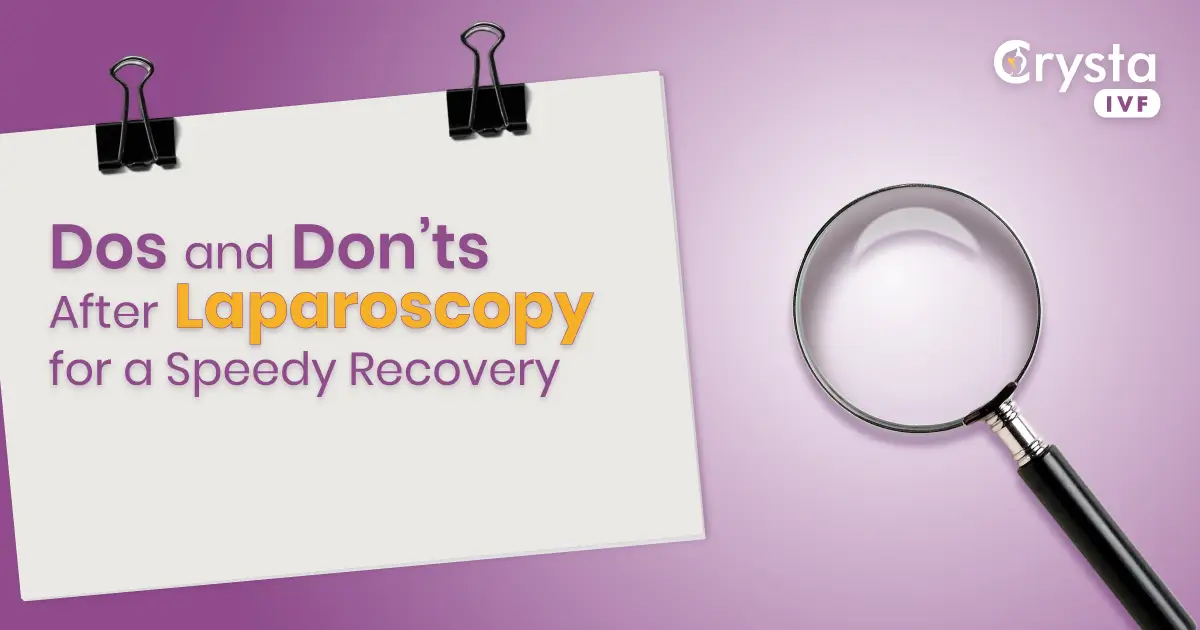Laparoscopic surgery is a great way to escape discomfort and enhance your quality of life. But the operation alone is not the end of the road to full recovery. A seamless and successful healing process after the surgery is necessary to recover completely.
Whether you have undergone laparoscopy to treat digestive diseases, address gynecological difficulties, or for any other reason, you must know what to do after the surgery for a speedy recovery.
This article will offer thorough instructions on how to take care of your body after the surgery, including the dos and don’ts for recovering from laparoscopy and getting back to your regular activities.
Understanding Laparoscopy for Infertility
Laparoscopy, also known as keyhole surgery, is a minimally invasive surgical technique that has several benefits over open surgery. By creating tiny incisions in the belly, the surgeon minimizes discomfort, lowers the risk of complications, and improves internal organ visibility.
These tiny holes serve as entrance points for inserting the specialized tools and the laparoscope, a thin tube equipped with a light source and camera for viewing and accessing interior organs.
Laparoscopy has emerged as a revolutionary method for diagnosing and treating infertility. It is an essential tool in the diagnosis and treatment of several underlying disorders that might make conception more difficult in the context of infertility.
What are the Dos and Don’ts after Laparoscopy?
Laparoscopy generally takes 24 hours to complete. However, in cases where the patient has a bad medical history, and the treatment is extensive, the duration of stay may grow to several days. Here are a few dos and don’ts that can help you recover faster.
Dos after Laparoscopy
- Observe What your Doctor has Prescribed.
The doctor will provide you with comprehensive information on how to care for yourself at home following laparoscopic surgery. It is essential to follow the doctor’s suggestions to guarantee a speedy recovery. Your doctor may instruct you on how to care for your incision sites, change your dressings, and return to your regular activities.
- Go Easy on Yourself
Laparoscopic surgery has the potential to cause physical harm to the patient, even if it is less intrusive than open surgery. After surgery, you must take it easy to give your body the time it needs to heal. Take a few days off from work and relax by listening to soothing music.
- Maintain Body Hydration
It’s important to stay hydrated following laparoscopic surgery. Constipation is one of the side effects of pain medication and restricted physical activity. One way to prevent constipation is to stay hydrated. Electrolyte drinks, clear broths, and water are ways to keep yourself hydrated.
- Slowly Increase Physical Activity
It’s important to gradually increase your physical activity as your body heals from laparoscopic surgery. Walking is an excellent way to start, as it can help prevent blood clots. Avoid vigorous exercise just after the surgery. Also, follow the fertility doctor’s advice to regain strength and mobility.
- Consume Healthy Foods
Food is a great way to increase your chances of speedy recovery after laparoscopy surgery. Consume a diet high in fruits, vegetables, whole grains, lean meats, seafood, and eggs. Avoid consuming heavy fat, sugar, or salt, as these might alter recovery and raise the possibility of problems.
- Ensure the Incision Sites Are Dry and Clean
After laparoscopic surgery, keeping the incision areas dry and clean is critical to avoid infection. The doctor will instruct you on how to care for the incisions, how often to clean them, and when to change your dressings.

Dont’s After Laparoscopy
- Don’t Lift Heavy Things
After laparoscopic surgery, lifting large and heavy objects can cause undue strain on the incision sites and impede the healing process. The doctor will probably advise you to avoid lifting anything heavier than 3 kg for at least a few weeks.
- Say No to Tobacco Products or Smoke
In addition to increasing the risk of problems, smoking and using tobacco products might slow down the healing process after laparoscopic surgery. Nicotine can slow the healing process and raise the risk of infection by narrowing blood vessels.
- Avoid Rescheduling Appointments
After laparoscopic surgery, it is important to schedule follow-up visits with your doctor to ensure everything is healing well and identify potential issues. You must visit the doctor on time and let the doctor know about any symptoms or problems you experience.
- Don’t Overdo Anything
After laparoscopic surgery, overdoing any work might cause difficulties and impede the healing process. Know from the doctor when to return to your regular activities and when to progressively increase your physical activity.
- Ignore Any Infection or Complicated Symptoms
Serious health issues can arise because of laparoscopic surgical consequences such as infections. It is critical to check for any symptoms, including fever, chills, or pain, and any indications of diseases, such as redness, swelling, or discharge from the incision sites. You must consult a doctor immediately if you encounter any of these symptoms.
When is Laparoscopy Recommended for Infertility?
The strongest indicator that you might need a laparoscopy to examine your pelvic region is when you are facing problems conceiving. Nevertheless, the following are some additional symptoms:
- Endometriosis diseases
- Abdominal or pelvic pain
- Ovarian Cysts
- Heavy menstrual cycles
- obstructed fallopian tube
How Long Does it Take to Recover From Laparoscopic Surgery?
Although everyone’s recovery following endometriosis laparoscopic surgery is different, most people can experience a healing period of two to four weeks. You could feel a little uncomfortable, tired, and in pain during the first few days after the surgery, but these side effects usually go away over time.
Recovery can go more smoothly if postoperative care instructions are followed, which include getting enough rest, taking medications on time, and showing up for follow-up appointments.
The Bottom Line
Laparoscopic surgery is a minimally invasive surgical method with several advantages over open surgery. However, to guarantee a full recovery, patients must still take a few measures, as mentioned in the dos and do n’ts after laparoscopy.
You’ll quickly regain your health if you adhere to the advice above. Please feel free to consult with the expert doctors at Crysta IVF if you are facing any infertility issues and are thinking of undergoing a laparoscopy. The doctors will examine you thoroughly and suggest the best possible solution for your problem.




